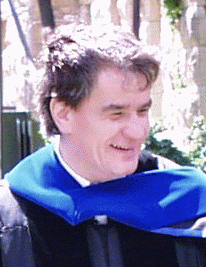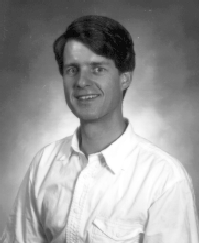
Departmental Newsletter Article
Note that no attempt has been made to maintain the links in older newsletters.
J.R. Macdonald Laboratory

The J.R.Macdonald laboratory is in the second year of its current three year operating grant from the U.S. Department of Energy. It is now an official national DOE user facility, with users from various parts of the U.S., Europe, and Japan.
A program advisory committee, consisting of four outside experts in ion-atom and ion-surface collisions and one internal member, invite proposals every six months. The proposals are evaluated and awarded on the basis of scientific merit, and the experiments are scheduled during the following period.
Outside pressure on the facilities has been high. The two major facilities, the CRYEBIS ion source and the Tandem-LINAC accelerator, are heavily scheduled by both in-house and external users. Proposals typically request more running time than is available, but nearly all experiments with strong scientific merit are accommodated.
A major transition in the atomic physics faculty in the department has been the appointment of Martin Stockli to associate professor of physics. Martin, who was the father of our CRYEBIS ion source, now has teaching duties added to his already too busy schedule. This has required that we find additional help for the daily management of the EBIS. We were fortunate to be able to attract Charles Fehrenbach, who was previously a research associate from Colorado State University living at K-State, to this position. We are also in the process of interviewing candidates for a new theory faculty position in the K-State atomic physics group.
We have been invited to present a special exhibit on the JRM facilities at the March centennial meeting of the American Physical Society in Atlanta. Our major display, which has been coordinated by Tracy Tipping, Kevin Carnes, Vince Needham and Martin Stockli will allow attendees to take a virtual tour of the laboratory and to operate our CRYEBIS ion source from Atlanta using the internet.
CRYEBIS Research
Research projects abound. At the CRYEBIS, five beamlines are being heavily used.
- Martin Stockli and his student Dan Fry are studying the momentum-space distributions of soft electrons ejected when highly charged ions strike graphite surfaces in grazing incidence.
- On a second line, a collaboration between Colorado State (Steve Lundeen) and K-State (Brett DePaola) is studying electron capture using lasers to prepare and probe Rydberg targets.
- On a third beamline a permanent COLTRIMS (COLD Target Recoil Ion Momentum Spectroscopy) apparatus is being used by Erge Edgu, a student of Lew Cocke, to examine, with a multi-particle-capable microscope, the momentum distributions of electrons and ions released in low-energy capture and ionization collisions.
- A fourth beamline is being used by Bob Dubois from the University of Missouri at Rolla and Imad Ali, a research associate at the JRM laboratory, to study the breakup patterns of molecules struck with slow, highly charged ions.
- A fifth beamline is used routinely by a collaboration from Himeji Institute in Japan, which is studying the production of ions with EBIS ions. In short, this facility is very heavily used. The room is so full of apparatus one can hardly cross it.
Tandem-LINAC projects
The Tandem-LINAC facility is similarly heavily used. Here are some current projects:
- Theo Zouros, from the University of Crete and his student Manolis Benis have developed on another beamline a new kind of very high efficiency electron spectrometer for taking high resolution electron spectra from fast ions on heavy targets.
- Pat Richard, laboratory director, Mahendrajit Singh, a research associate in the JRM laboratory; and Ridvan Unal have recently constructed an improved COLTRIMS apparatus that is seeing its first tests just as this letter is being written.
- Habib Aliabadi, a student of Pat Richard, and Mark Gealy, on sabbatical from Concordia College, are working on an improved high resolution electron spectrometer for high energy electrons.
- Siegbert Hagmann has begun work on a new scattering chamber for electron spectroscopy on this facility.
- Itzhak Ben-Itzhak with his student Eric Wells are performing an experiment which has revealed a fractionation of deuterium and hydrogen in collisional processes involving HD molecules.
- A COLTRIMS apparatus has been recently used by Allen Landers, a student of Lew Cocke, to study soft electron production by fast heavy ions, making use of the special timing capabilities of the LINAC.
- The ion-ion collision facility, which is rather specialized in its capabilities, is being prepared for the study of ion-molecular-ion collisions by Ingrid Reiser, a student of Martin Stockli. This facility is fed by an electron-cyclotron resonance source, and this source will soon be arranged so the Colorado State group can use it as well.

|
For more information These projects, as well as much more information on the laboratory, can be viewed at the JRM web page. The URL is http://jrm.phys.ksu.edu. We have Vince Needham to thank for putting up and maintaining this page.
Lew Cocke
|
Research in Atomic and Surface Theory
 Interactions between
ions and surfaces are not yet well understood
at a microscopic level despite their importance for applications in surface
chemistry (catalyses, corrosion prevention), accelerator design, and
controlled fusion devices. Similarly, the detailed understanding of
electron--transfer and electron emission in collisions between ions and
fullerenes is of relevance for future applications. These collisions
yield information on the physical and chemical properties of fullerenes
that may enable the successful syntheses of new materials (fullerene
chemistry).
Interactions between
ions and surfaces are not yet well understood
at a microscopic level despite their importance for applications in surface
chemistry (catalyses, corrosion prevention), accelerator design, and
controlled fusion devices. Similarly, the detailed understanding of
electron--transfer and electron emission in collisions between ions and
fullerenes is of relevance for future applications. These collisions
yield information on the physical and chemical properties of fullerenes
that may enable the successful syntheses of new materials (fullerene
chemistry).
Uwe Thumm is continuing to work on the theory of ion-surface collisions, ion-cluster interactions, and slow electron--atom collisions. Drs. Bogdana and Cristian Bahrim joined him in February as post doctoral research associates. Both got their PhD (equivalent) degrees at the University of Paris XI specializing in the theory of ion--surface interactions (Bogdana) and the theory of slow ion--atom collisions (Cristian).
Bogdana is developing a new, non-perturbative ab-intio ion-surface scattering calculation that includes an interesting new continuum discretization method to represent continuous solid state electronic wave functions.
Cristian is working on the interaction of slow electrons with Alkali atoms within Uwe's relativistic R-matrix approach. Motivated by very recent experiments, Cristain is now extending this method to investigate photo-detachment of negative ions.
During April and May, Uwe was joined by one of his German collaborators, Jens Ducree from the University of Muenster, to continue work on a computer simulation that by now reproduces various recently measured observables during the interaction of highly charged ions with metal and insulating surfaces. Another visitor, Priv. Doz. Dr. Uwe Wille from the Hahn-Meitner Institute in Berlin, came to our department in October in order to work with Uwe Thumm on the emerging field of ions interacting with thin metallic films.
During the past summer, Uwe (again) spent several weeks in Europe to collaborate with colleagues at the Manne Siegbahn Institute in Stockholm on interactions of ions with Buckyballs (C60) and in Berlin to continue a collaboration on ion-surface scattering theory. During this trip he gave invited talks in Stockholm, Sweden; Aarhus, Denmark; Freiburg, Germany; Copenhagen, Denmark; and at the 12th International Workshop on Collisions Involving Atomic Clusters, held in Sonderborg, Denmark in June.
In January 1999, Uwe presented an invited talk at the 12th International Workshop on Inelastic Ion-Surface Collisions, on South Padre Island, Texas.
Uwe's work is well funded. Apart from being attached to the Macdonald Laboratory block grant, he has his own NSF grant and recently received an award from the DOE Office of Fusion Energy to investigate the simultaneous interaction of atoms and negative ions with both static and laser external fields.